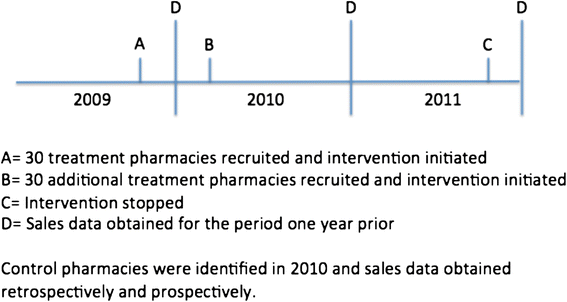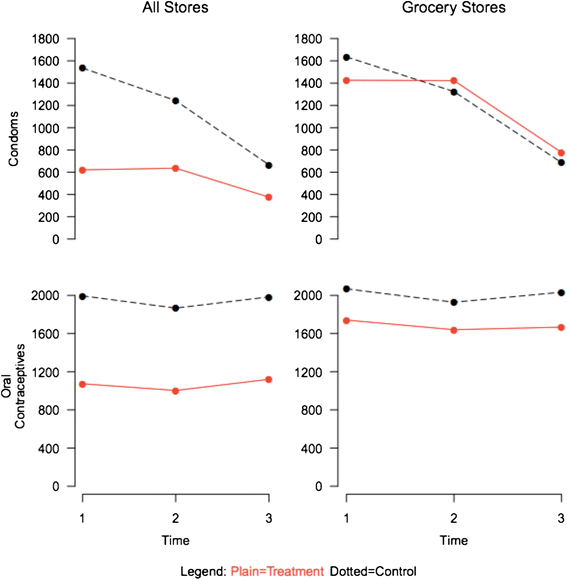Impact of a passive social marketing intervention in community pharmacies on oral contraceptive and condom sales: a quasi-experimental study
- PMID: 25885775
- PMCID: PMC4340340
- DOI: 10.1186/s12889-015-1495-x
Impact of a passive social marketing intervention in community pharmacies on oral contraceptive and condom sales: a quasi-experimental study
Abstract
Background: Almost 50% of pregnancies in the United States are unwanted or mistimed. Notably, just over one-half of unintended pregnancies occurred when birth control was being used, suggesting inappropriate or poor use or contraceptive failure. About two-thirds of all women who are of reproductive age use contraceptives, and oral hormonal contraceptives remain the most common contraceptive method. Often, contraceptive products are obtained in community pharmacies. The purpose of this study was to determine whether a pharmacy-based intervention would impact sales of contraceptive products in pharmacies.
Methods: This study was conducted in Iowa and used a quasi-experimental design including 55 community pharmacies (independent and grocery) in 12 counties as the intervention and 32 grocery pharmacies in 10 counties as a comparison group. The passive intervention was focused towards 18-30 year old women who visited community pharmacies and prompted those of childbearing age to "plan your pregnancy" and "consider using birth control". The intervention was delivered via educational tri-fold brochures, posters and 'shelf talkers.' Data sources for evaluation were contraceptive sales from intervention and comparison pharmacies, and a mixed negative binomial regression was used with study group*time interactions to examine the impact of the intervention on oral contraceptive and condom sales. Data from 2009 were considered baseline sales.
Results: From 2009 to 2011, condom sales decreased over time and oral contraceptives sales showed no change. Overall, the units sold were significantly higher in grocery pharmacies than in independent pharmacies for both contraceptive types. In the negative binomial regression for condoms, there was an overall significant interaction between the study group and time variables (p = 0.003), indicating an effect of the intervention, and there was a significant slowing in the drop of sales at time 3 in comparison with time 1 (p < 0.001). There was a statistically significant association between pharmacy type and study group, where the independent intervention pharmacies had a higher proportion of stores with increases in condom sales compared to grocery pharmacies in the intervention or comparison group.
Conclusions: A passive community pharmacy-based public health intervention appeared to reduce the decrease in condom sales from baseline, particularly in independent pharmacies, but it did not impact oral contraceptive sales.
Figures
Similar articles
-
Unlocking the condoms: The effect on sales and theft.Pharm Pract (Granada). 2011 Jan;9(1):44-7. doi: 10.4321/s1886-36552011000100007. Epub 2011 Mar 15. Pharm Pract (Granada). 2011. PMID: 25132889 Free PMC article.
-
The effect of price increases on contraceptive sales in Bangladesh.J Biosoc Sci. 1994 Jan;26(1):25-35. doi: 10.1017/s0021932000021039. J Biosoc Sci. 1994. PMID: 8200877
-
Pharmacy staff perceptions and self-reported behaviors related to providing contraceptive information and counseling.J Am Pharm Assoc (2003). 2015 Sep-Oct;55(5):481-7. doi: 10.1331/JAPhA.2015.15037. J Am Pharm Assoc (2003). 2015. PMID: 26359958
-
The impact of condom prices on sales in social marketing programs.Stud Fam Plann. 1994 Jan-Feb;25(1):52-8. Stud Fam Plann. 1994. PMID: 8209395 Review.
-
Impact of the 2013 French Pill Crisis on Women's Behaviour Regarding Contraception.Drugs Real World Outcomes. 2015 Mar;2(1):13-22. doi: 10.1007/s40801-015-0011-z. Drugs Real World Outcomes. 2015. PMID: 27747613 Free PMC article. Review.
Cited by
-
Systematic Review of Peer-Reviewed Literature on Global Condom Promotion Programs.Int J Environ Res Public Health. 2020 Mar 27;17(7):2262. doi: 10.3390/ijerph17072262. Int J Environ Res Public Health. 2020. PMID: 32230929 Free PMC article.
References
-
- Guttmacher Institute. Facts on unintended pregnancy in the United States. [http://www.cdc.gov/cdcgrandrounds/archives/2014/oct2014.htm]
Publication types
MeSH terms
Substances
LinkOut - more resources
Full Text Sources
Other Literature Sources




